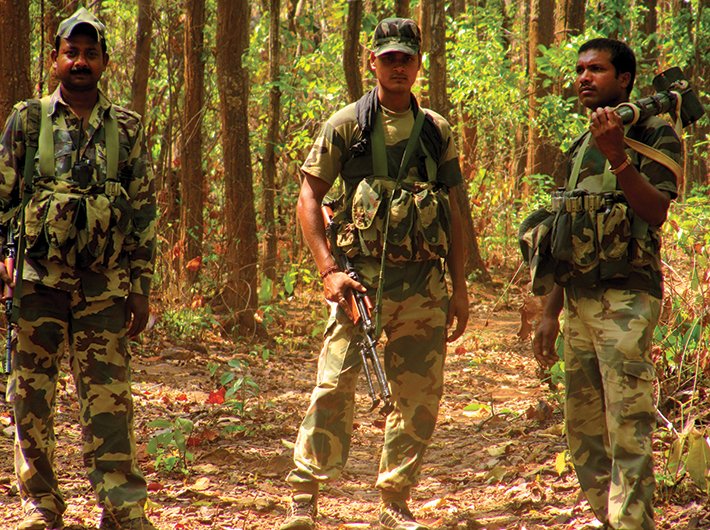As he completed the first year of his second term on May 24, 2010, the then prime minister Manmohan Singh made a statement in a press conference that became a reference point for all future discourse on left-wing extremism (LWE) or Maoism/Naxalism as it is commonly known. He said, “I have been saying for the last three years that Naxalism remains the biggest internal security challenge facing our country.”
The remark was made against the backdrop of one of the deadliest Naxal attacks on security forces by Maoists. On April 6, 2010, 76 CRPF jawans were killed in an ambush by insurgents near Chintalnar village in Dantewada, Chhattisgarh.
The former PM’s remark continued to be relevant. “By far the most powerful insurgent groupings active in India are the Naxalites,” writes Chris Ogden, senior lecturer in Asian Security at the School of International Relations, University of St Andrews, Scotland. In his ‘Indian National Security’ (2017), he notes, “Formed in 1967 around a Maoist left-wing ideology, they largely represent indigenous tribal communities (Adivasis) and the lower caste with regard to land right unemployment, and the socio-economic exclusion. Active across at least a third of Indian states via the oft referred to ‘red corridor’ stretching from the north to the south of the country, the Naxalites caused over 7,300 deaths between 2005 and 2016. Although annual deaths are below their zenith of 1,180 in 2002, Naxalite activity accounted for nearly half of all such fatalities occurring across India in 2016.”
Shrinking base of LWE
In the last four years, however, the ‘biggest internal security threat’ has gradually been diminished, thanks to a host of initiatives to ensure a strategic and perception edge over the insurgents. The ‘red corridor’ has been substantially shrunk. One of the biggest indicators of the shrinking base of LWE is the fact that in April the union government removed 44 districts from the list of 126 Naxalism-hit districts (while adding eight to it). The number of the worst-affected districts also came down from 35 to 30.
The home ministry data also highlight the positive development. In 2017, for the first time since 1989 the number of LWE-related violent incidents has been less than 1,000. Incidents of violence have seen a 20 percent decline with a 34 percent reduction in related deaths in 2017 as compared to 2013. The geographical spread of LWE violence has also shrunk from 76 districts in 2013 to just 58 districts in 2017.
As union home minister Rajnath Singh put it in May, “Naxalism is a challenge, but I want to say that this menace is now shrinking. Casualties among security forces have declined by 53-55 percent. The geographical expanse of LWE-affected areas has also decreased by 40-45 percent.” Speaking at the passing out parade of the CRPF’s Bastariya Battalion in Chhattisgarh, he further added, “We have also decided that all those left-wing extremism leaders who have earned money by using poor people and manipulating their innocence will be punished.”
This was a clear indication that the government was using a manifold strategy of demolishing the logistical as well as ideological edifice of Naxalite insurgency.
At a meeting of the chief ministers of the LWE-affected states in May last year, the union home minister had announced a new strategy against the Maoists: SAMADHAN. The acronym stands for Smart leadership, Aggressive strategy, Motivation and training, Actionable intelligence, Dashboard-based KPIs (key performance indicators) and KRAs (key result areas), Harnessing technology, Action plan for each theatre and No access to financing. It was projected as totally new paradigm to tackle the left-wing extremism.
Speaking about ‘No access to financing’, Rajnath Singh said that in fighting LWE groups the most important strategy should be to choke the funding, which shall prevent them from getting weapons, ammunition and basic amenities that sustains their ill-found mission.
To that end, the NDA government targeted NGOs allegedly helping LWE groups. In its first 30 months, functioning licences of around 20,000 of the total 33,000-odd functioning NGOs were cancelled, primarily for allegedly violating various provisions of the Foreign Contribution (Regulation) Act, 2010 (FCRA) and in some cases for allegedly engaging in antinational activities, thus barring them from receiving foreign funds.
Counteracting through development
Marxist intellectual Antonio Gramsci recommended how struggle against the establishment or an idea can be fought in two ways: ‘War of position’, an intellectual and cultural struggle where the ideology that perpetuates a certain social order or perception of what is right is dismantled by putting forward an alternative idea, and ‘war of manoeuvre’, direct frontal attack on the establishment.
After dealing with Maoists for decades, the home ministry seems to have become well versed in the Gramscian tactics. From direct attacks on insurgents, the ministry also, through various development initiatives in the last four years, has tried to gradually rein in through its own ‘war of position’.
Under the road requirement plan (RRP), 1,615 kilometres of roads have been constructed in last four years to improve connectivity in 38 LWE-affected districts of eight states. As many as 2,329 mobile towers have been installed for better communication connectivity. To ensure access for all to the formal banking system, 450 bank branches have been opened and 1,123 ATMs installed.
With these and other development initiatives, substantive inroads have been made in filling the gaps that insurgents exploited by evoking a sense of relative deprivation among the poor tribals.
Marking development as the most potent weapon to fight the Maoists, Rajnath Singh said in Chhattisgarh in May, “I know that
chief minister Dr Raman Singh is trying to ensure overall development of Chhattisgarh. He is focused on developing the remotest areas of the state to ensure inclusive development. However, Maoists do not want these areas to develop as they very well know that if development takes place their sinister plan will never succeed.”
He added, “We have been ensuring road connectivity, electricity and other infrastructure to every village in the state. Some villages are still deprived of electricity and the people are suffering due to hurdles created by the Naxals. But I want to assure that no obstacle can stop the development process in these areas.”
This, of course, is a continuation of the previous government’s preferred solution, which was not effectively implemented. Ogden, while referring to Manmohan Singh’s statement that termed LWE as the biggest internal security challenge, writes that the former PM also considered “economic development the best way to counteract them”. He adds, “Perception and history thus play a major role in the Naxalites being an established threat in India.”
Countering the Naxals ideologically has also been one of the key strategies of the union government. In April, speaking at a public event in Bijapur, one of the worst LWE-affected districts, prime minister Narendra Modi appealed the tribals of Bastar region to understand the fact that Naxal leaders were merely using them to achieve their own ulterior motives.
Modi said, “I would like to tell the youngsters who have deviated to the path of violence that Babasaheb Ambedkar has given us the Constitution. He has taken care of your rights in the Constitution. It is the responsibility of the government to think about your rights. You don’t have to take up arms and resort to violence.”
On a more emotional note, he added: “I would also like to tell the mothers and the fathers that some of your sons and daughters have meandered to this path. However, just think about who their leader is. Not a single leader belongs to your area. The leader was not born among you. They are outsiders. The leaders do not die. They go and hide in the forests and are safe while your children are the ones who are dying in this violence. ...Why are you giving them the rights to kill your children?”
Numbers and trends seem to show that this emotional appeal is working.
feedback@governancenow.com
(The article appears in the July 15, 2018 issue)

